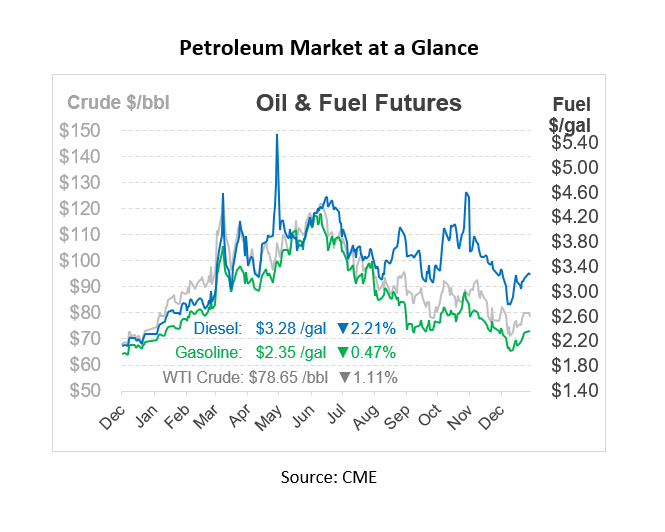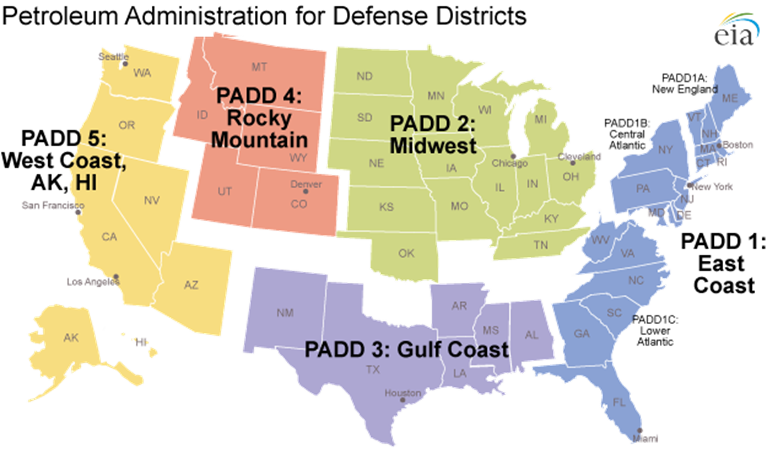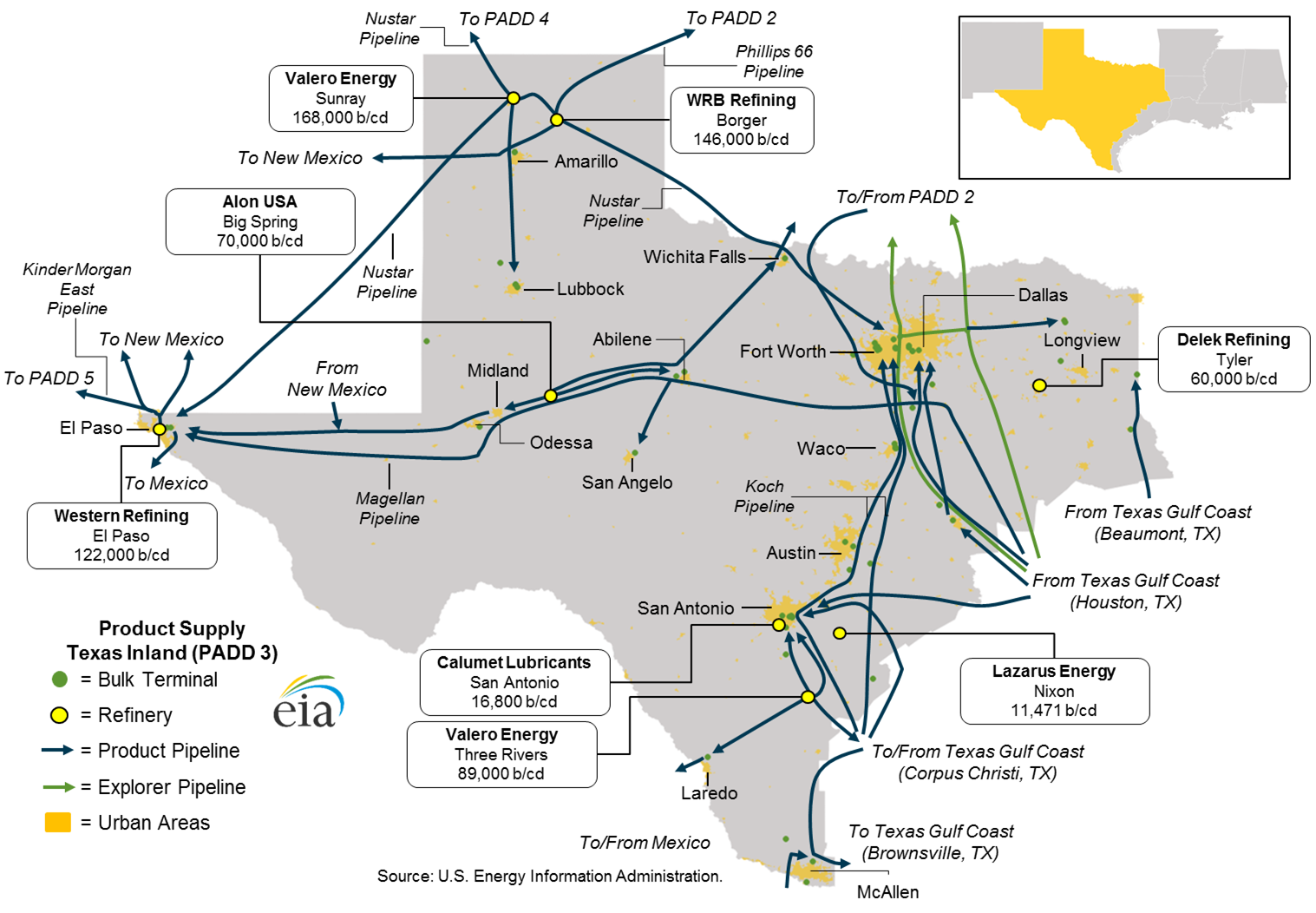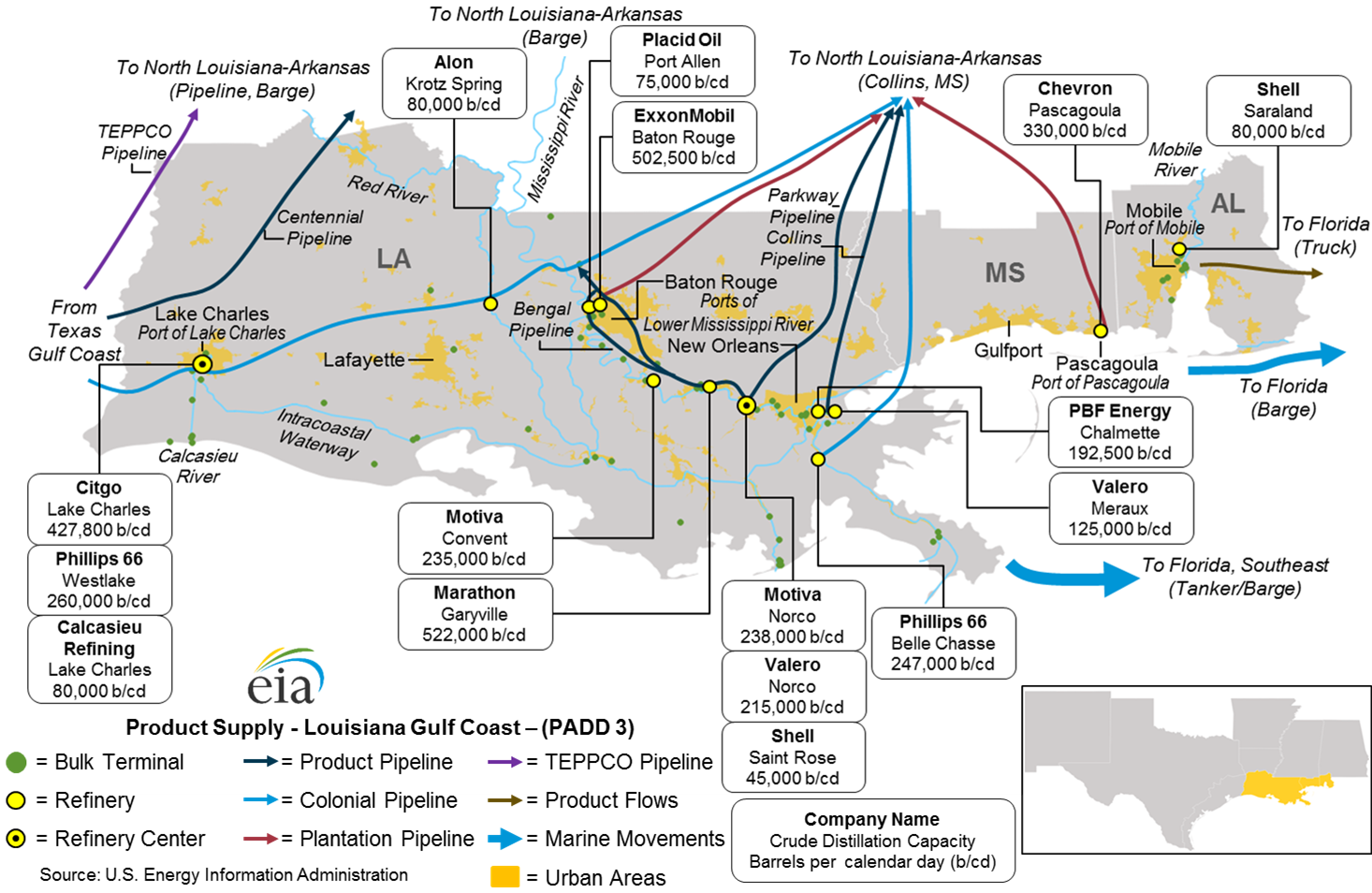
What Is It – PADD 3
After learning about PADD 1 and PADD 2 in detail, it’s time to dive into PADD 3 (Gulf Coast), which is the powerhouse of the US oil industry. From oil production in West Texas to refining and exports, the Gulf Coast sets the trend for nearly all facets of the American energy industry. Today, we’ll explore the ins and outs of PADD 3, the only PADD to touch every other region.
What is PADD 3
PADD 3 is located on the Gulf Coast, housing six states, including Alabama, Arkansas, Louisiana, Mississippi, New Mexico, and Texas.
Within those states are three of the US’s seven major oil basins: Eagle Ford, Haynesville, and the Permian. Texas alone produces over 5 million barrels of oil per day – more than PADDs 1, 2, 4, and 5 combined. New Mexico is second, producing 1.7 MMbpd.
PADD 3 boasts the largest refining capacity in the US, converting enough fuel each day to feed nearly half of the US’s total daily fuel consumption. Although many refiners are configured to refine Texas’s light, sweet crude, the region also imports crude oil from other regions, including Canada, to be refined or exported abroad.
What Makes PADD 3 Unique?
The Gulf Coast is notable for being the powerhouse of American energy, with Texas dominating the landscape. It also combines production and refining in a concentrated area, boasting the lowest average distance between refineries and crude oil production facilities. With less travel time, transporting oil to refineries is easier than in other more spread-out PADDs, ultimately resulting in lower transportation costs and a greater output volume.
Because it produces more than it consumes, PADD 3 is in the unique position of experiencing lower fuel prices during certain supply emergencies. When the Colonial Pipeline is offline, for instance, fuel is stranded at the source, resulting in lower local prices. While other regions must contend with the supply reliability concerns that come from importing fuel, PADD 3 only needs enough storage capacity to keep up with the backlogs.
Because PADD 3 is located entirely in the South, it rarely has to contend with cold weather. Over the past few years, winter storms have become increasingly common, requiring the region to learn how to winter-proof its operations. From winter diesel additives to securing their power sources, these southern states are facing new challenges not seen in the past.
PADD 3 Quick Stats
Total Fuel Consumption: 6.2 MMbpd (2022)
Gasoline Consumption: 1.4 MMbpd (2022)
Diesel Consumption: 840 kbpd (2022)
Crude Oil Production: 8.4 MMbpd
Refinery Net Production: 9.5 MMbpd (2022)
Total Number of Refineries: 54 (2022)
Let’s Meet PADD 3
Because PADD 3 is so packed with energy producers and refiners, it’s also home to a labyrinth of crude oil and refined product pipelines. Unpacking PADD 3 requires a detailed look at small chunks of the landscape, especially in Texas. The Texas area can be divided into two – the coastline and inland Texas.
Coastal Texas could be a PADD all on its own, with 17 refineries spanning Houston, Beaumont, Corpus Christi, and Brownsville. These areas are also busy ports, with crude oil tankers bringing oil from overseas and crude oil and refined fuel tankers leaving to export fuels abroad. If you’ve ever visited these coastal cities, you’ve likely seen the massive refinery complexes while driving down the highway or traveling near the Gulf of Mexico.
When you pass the coastal areas, you’re in for a winding web of pipelines that connect crude oil fields to refiners, and refiners to consumers. Refined fuel pipelines transport fuel from coastal markets into the country, traveling north to Dallas or south to Mexico. From Dallas, the fuels may travel northward into PADD 2 or westward toward El Paso. Western Texas has disproportionately high diesel demand due to oil drilling operations, so it relies on shipments from the coast to keep its oil fields running. Some small refineries in Northern Texas supply the northern population centers.
Texas is by no means the only player among the Gulf Coast states. Louisiana, Mississippi, and Alabama each have large refineries working tirelessly to supply fuels. Most of these refineries are putting their supply on the Colonial and Plantation pipeline, for use in PADD 1. In some cases, they may also be exporting some from major oil ports. Both coastal Texas and these coastal areas are at risk of hurricanes during the late summer and early fall season.
Further from the coast, New Mexico is reliant on Texas refineries for product, though they do have a couple of scattered refineries providing local supply. Fuel is shipped in by pipeline from El Paso and from the Texas panhandle. The Kinder Morgan East Pipeline also carries fuel across the state over to Phoenix, AZ.
Finally, the northern areas of Louisiana, Mississippi, and Alabama receive relatively little attention given the tiny refineries populating this area. However, this area is very important from a pipeline standpoint, since the TEPPCO Pipeline heads northward from Arkansas into PADD 2 and the Colonial and Plantation pipelines flow northeast towards PADD 1. The Mississippi River also cuts through this territory, allowing barge shipments to flow up and down the river.
This article is part of Daily Market News & Insights
Tagged: crude, Daily Market News & Insights, inventory, padd 3, production, Supply, wti crude
MARKET CONDITION REPORT - DISCLAIMER
The information contained herein is derived from sources believed to be reliable; however, this information is not guaranteed as to its accuracy or completeness. Furthermore, no responsibility is assumed for use of this material and no express or implied warranties or guarantees are made. This material and any view or comment expressed herein are provided for informational purposes only and should not be construed in any way as an inducement or recommendation to buy or sell products, commodity futures or options contracts.












